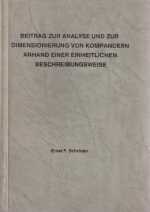Contribution to Analysis and Dimensioning of Companders by utilizing a Unified Description
PhD Thesis of Ernst F. Schroeder
07 July 1989
I am sorry, this thesis has been written in German. But at least I can provide you
with a summary and table of contents.
Finally I have been able to scan the document, so you can
download it here (pdf, 17.4 MB).

|
I have dedicated this work to Professor Dr. Walter Bruch, my teacher and
first boss, who has not only been the operator of one of the first electronic "Iconoscope" TV cameras
at the 1936 Olympics in Berlin, but who was also the inventor of the PAL color
TV system.
|
Compander (or Compandors) for audio signals are signal processing building blocks, which
aim at squeezing audio signals with high signal-to-noise ratio through a transmission channel
with a much lower signal-to-noise ratio, and without affecting the audible signal quality.
They do this by exploiting the properties of human hearing.
A unified description is presented, which not only leads to criteria for judging how
effectively a certain type of compander works, but also leads to guidelines on how to choose
working parameters.
It is shown, how the description of an instantaneous compander can be extended to
a syllabic compander, when a control quantity is derived by a suitable smoothing operation. Examples
for such smoothing operations and methods to determine their parameters are given.
It is further shown, how a certain time-nonlinear smoothing operation with switchable
decay time constant is best adapted to the properties of human hearing. This method has
been realized in the compander system for consumer application, which has been developed
by the author and which has been marketed under the brand name HIGH COM.
Finally it is shown, how the unified description, initially intended for the time domain,
can be extended to a more general description of companders in the frequency domain. This view
leads from a syllabic compander to a formant compander,
which has even better efficiency by utilizing the frequency domain properties of human hearing.
- Introduction
- Transmission of Electroacoustic Signals
- The Goals of Electroacoustic Signal Transmission
- Sources and Sinks of Information
- Source Coding
- Typical Transmission Channels
- Reception of Information via the Human Ear
- Specially Adapted Source Coders and Source Decoders
- Tasks to be Solved
- Special Properties of Human Hearing
- Detection Capabilities
- Masking of Simultaneous Sounds
- Pre- and Post-Stimulus Masking
- Conclusion
- Transmission Channel with Compander
- The General Priciple of Companding
- The General Companding Law
- Criteria for Assessment
- Instantaneous Companders
- Basic Priciples
- Criteria for Assessment
- Examples of Instantaneous Companding Laws
- The Law of Powers
- The Logarithmic Law
- Non-Monotonuous and Non-Continual Laws
- Signal Distortions
- Comparison of Results
- Syllabic Companders
- Basic Principles
- Signal Represenation in the Time Domain
- Examples of Syllabic Companding Laws
- Criteria for Assessment
- Examples for Syllabic Companders
- Conclusions
- Deriving a Control Quantity for Syllabic Companders
- General Task
- Deriving an Approximation to the Signal Envelope
- Smoothing with Low-Pass Filter of 1st Order
Attack, Decay and Nonlinear Distortions
- Smoothing with Low-Pass Filter of higher Order
Attack, Decay and Nonlinear Distortions
- Nonlinear Smoothing
Attack, Decay and Nonlinear Distortions
- Further Special Methods
- Split Frequency Band
- Time Delay
- Nonlinear Smoothing with Signal-Dependent Time Constant
Attack, Decay and Nonlinear Distortions
- Summary
- Companding in the Frequency Domain
- Prerequisites
- Signal Representation in the Frequency Domain
- Companding in the Frequency Domain
- Deriving and Smoothing of Spectral Functions
- Definition and General Realisation of "Formant Companding"
- Special Approximative Solutions
- Split-Band Companders
- Sliding-Band Companders
- Companders with fixed Pre-/Deemphasis
- Conclusions
- Overall Summary
- Appendix
- Proof of Equation (7.17)
i.e. that and how compressors and expanders with either input-derived
or output-derived control quantities can be dimensioned to have identical behaviour
- Examples of Signals, Envelopes, and Smoothened Control Quantities
- References
URL of this page:
http://www.ernstschroeder.de/phd.htm
For any questions concerning this page please contact me via EMail.
Copyright © Ernst F. Schroeder, all rights reserved.

